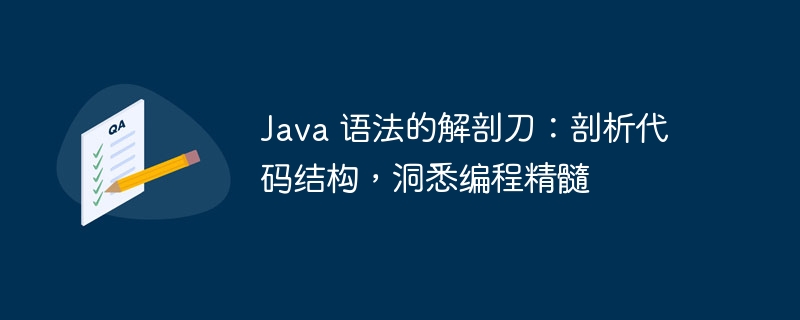 Java
Java
 javaTutorial
javaTutorial
 The scalpel of Java syntax: analyze the code structure and gain insight into the essence of programming
The scalpel of Java syntax: analyze the code structure and gain insight into the essence of programming
The scalpel of Java syntax: analyze the code structure and gain insight into the essence of programming

The scalpel of Java syntax: analyze the code structure and gain insight into the essence of programming Java language is a high-level programming language widely used in the field of software development. It is known for its concise and elegant syntax and powerful cross-platform features, making it the first choice of many developers. However, for beginners who are new to Java, its complex syntax rules and code structure are often daunting. In this article, we will let PHP editor Youzi analyze the internal mechanism of Java syntax for everyone, gain an in-depth understanding of the components of the code, and help readers clarify their clues and master the essence of programming. Whether you are a beginner or an experienced developer, you can gain practical knowledge and skills from this article and improve your coding level. Let us uncover the mysteries of Java syntax together!
The core structures of Java code are classes and objects. A class is a blueprint for code, defining data and methods, while an object is an instance of a class, containing the actual data and behavior. When an object is created, memory space is allocated according to the definition of the class.
Inheritance and polymorphism
Inheritance allows subclasses to inherit properties and methods from parent classes and extend the functions of parent classes. Polymorphism allows subclass objects to use the same interface as the parent class, but have different behavior. This provides code reusability and extensibility.
interface
The interface defines a set of methods but has no implementation. Classes can implement multiple interfaces to provide specific functionality. Interfaces ensure pluggability and loose coupling of code.
Access modifier
Access modifiers control the visibility of code, including public (global visibility), protected (visible to subclasses and the same package), default (visible to the same package), and private (visible only within the class).
Control flow
Control flow statements are used to control the flow of code execution. Conditional statements (if-else) and loops (for, while) are common control flow structures. The exception handling mechanism allows developers to handle error situations gracefully.
type of data
Java provides a variety of basic data types (such as int, double, boolean) and reference types (such as String, List). Each type has its specific uses and characteristics.
Operator
Operators are used to operate on data. Java provides arithmetic operators ( , -), logical operators (&&, ||) and bitwise operators (<<, >>).
method
Methods are encapsulations of code blocks and are used to perform specific tasks. Methods can have input parameters and return values. Method overloading allows defining methods with different parameter lists using the same name.
Packages and Imports
Package organizes and encapsulates related code to prevent naming conflicts. Import statements allow code to access classes and interfaces defined in other packages.
Comments
Comments add documentation and explanation to the code. Single-line comments (//) and multi-line comments (/ /) help other developers understand the purpose and usage of the code.
Analysis code example
public class Person {
private String name;
private int age;
public Person(String name, int age) {
this.name = name;
this.age = age;
}
public String getName() {
return name;
}
public int getAge() {
return age;
}
}This is a simple human class. It contains private fields to store name and age, has constructors to initialize these fields, and accessor methods to retrieve field values.
By dissecting Java syntax, developers can deeply understand the code structure and programming essence. This helps improve the readability, maintainability and scalability of the code, ultimately improving the quality and efficiency of software development.
The above is the detailed content of The scalpel of Java syntax: analyze the code structure and gain insight into the essence of programming. For more information, please follow other related articles on the PHP Chinese website!

Hot AI Tools

Undresser.AI Undress
AI-powered app for creating realistic nude photos

AI Clothes Remover
Online AI tool for removing clothes from photos.

Undress AI Tool
Undress images for free

Clothoff.io
AI clothes remover

AI Hentai Generator
Generate AI Hentai for free.

Hot Article

Hot Tools

Notepad++7.3.1
Easy-to-use and free code editor

SublimeText3 Chinese version
Chinese version, very easy to use

Zend Studio 13.0.1
Powerful PHP integrated development environment

Dreamweaver CS6
Visual web development tools

SublimeText3 Mac version
God-level code editing software (SublimeText3)

Hot Topics
 1385
1385
 52
52

